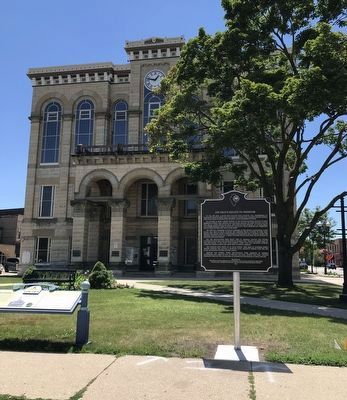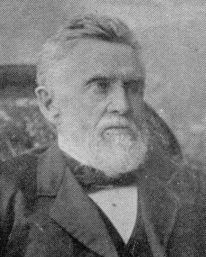Ottawa in LaSalle County, Illinois — The American Midwest (Great Lakes)
Jim Gray's Escape to Freedom
On October 19, with a crowd waiting at the Ottawa railroad station on East Marquette Street, Gray arrived. His legs were chained, his arms pinioned and he was led by a rope around his neck. Abolitionist John Hossack, an Ottawa grain and lumber merchant born in Scotland, called out “What crime has he committed? Has he done anything but want to be free?”
The next day, hundreds of people gathered at the Ottawa courthouse. Caton ruled Gray free of state charges, but ordered Gray's captors to take Gray before the United States Commissioner at Springfield for a hearing under the federal Fugitive Slave Law. A likely outcome would have been Gray's return to Missouri and enslavement.
But the abolitionists were ready. The U.S. Marshal leaving the Ottawa courthouse with Gray was restrained by several men. Hossack grabbed Gray by the arm saying “If you want your liberty, come!” Gray was escorted outside, where he jumped a fence and leapt into a waiting carriage.
The carriage sped north on La Salle Street, then east on Superior Street before crossing the Illinois & Michigan Canal aqueduct bridge over the Fox River and heading onward toward Canada.
Hossack and several other abolitionists were arrested by federal authorities and taken to jail in Chicago for trial. During the trial, Chicago residents treated the Ottawa men as celebrities for helping in Gray's escape.
Erected 2022 by The Ottawa Historic Preservation Commission • The La Salle County Bar Association • The William G. Pomeroy Foundation • The Illinois State Historical Society.
Topics and series. This historical marker is listed in these topic lists: Abolition & Underground RR • African Americans • Law Enforcement. In addition, it is included in the William G. Pomeroy Foundation series list. A significant historical date for this entry is October 20, 1859.
Location. 41° 20.804′ N, 88° 50.545′ W. Marker is in Ottawa, Illinois, in LaSalle County. Marker is at the intersection of West Madison Street and La Salle Street (Illinois Route 23), on the right when traveling east on West Madison Street. Marker is in front of the old La Salle County Courthouse. Touch for map. Marker is at or near this postal address: 119 W Madison St, Ottawa IL 61350, United States of America. Touch for directions.
Other nearby markers. At least 8 other markers are within walking distance of this marker. Lincoln the Litigator (here, next to this marker); In Memory of W.R. Foster (a few steps from this marker); Lasalle County Courthouse (within shouting distance of this marker); Stephen Douglas (within shouting distance of this marker); Board of Supervisors (within shouting distance of this marker); Abraham Lincoln (within shouting distance of this marker); The Daily Times (about 500 feet away, measured in a direct line); Lincoln Slept Here (about 600 feet away). Touch for a list and map of all markers in Ottawa.
Regarding Jim Gray's Escape to Freedom. It is not known what happened to Gray after he reached Canada. Hossack, whose Ottawa mansion was a station on the Underground Railroad, and seven others were charged in Gray's escape. Following a five-day trial in early 1860, Hossack was found guilty and sentenced to 10 days in jail, a $100 fine and court costs. Two co-defendants also were convicted and received similar sentences. The courthouse from which they helped Gray make his escape was destroyed in an 1881 fire.
Also see . . .
1. Speech of John Hossack. Text of his famous speech, delivered following his conviction, in which he swore he "had no sense of guilt" and that "it is the inhuman and infamous law that is wrong, not me." The speech later became a widely published anti-slavery tract. (Project Gutenberg) (Submitted on July 10, 2022, by Duane and Tracy Marsteller of Murfreesboro, Tennessee.)
2. Report of the Trial of John Hossack, indicted for rescuing a fugitive slave ... (PDF). Comprehensive report of testimony, evidence, and arguments from Hossack's 1860 trail for violating the federal Fugitive Slave Act. (Library of Congress) (Submitted on July 10, 2022, by Duane and Tracy Marsteller of Murfreesboro, Tennessee.)
Credits. This page was last revised on October 16, 2022. It was originally submitted on July 10, 2022, by Duane and Tracy Marsteller of Murfreesboro, Tennessee. This page has been viewed 505 times since then and 39 times this year. It was the Marker of the Week October 16, 2022. Photos: 1, 2, 3. submitted on July 10, 2022, by Duane and Tracy Marsteller of Murfreesboro, Tennessee.


